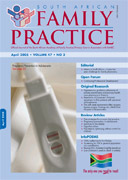Continuing professional development.
Abstract
It would be unlikely that many of today’s practicing family doctors have not been involved in Continuing Medical Education (CME) activities. It would be equally unlikely, however, that these activities were part of any contextually structured educational plan towards professional development. Often driven by external need towards a reaccredidation procedure, CME can be seen as a burden upon the average practitioners working day, or more usually evening. The concept of Continuing Professional Development takes the practitioner away from these short-term goals and moves them into a planned educational environment. Using the principles of adult education, this article supports the concept of Continuing Professional Development and demonstrates the value to the practitioner of an educational activity that is both relevant andpurposeful towards daily practice, hopefully equally beneficial to the practitioner and patient alike. This article considers some of the theory that underlies the change from Continuing Medical Education ( CME ) to Continuing Professional Development (CPD), the evidence for its effectiveness, and the ways in which CPD interacts with the processes of appraisal and assessment of medical practitioners. “If I have seen further, it is by standing on the shoulders of giants Isaac Newton 1676 (SA Fam Pract 2005;47(3): 5-6)
Published
2005-04-01
Section
Forum
By submitting manuscripts to SAFP, authors of original articles are assigning copyright to the South African Academy of Family Physicians. Copyright of review articles are assigned to the Publisher, Medpharm Publications (Pty) Ltd, unless otherwise specified. Authors may use their own work after publication without written permission, provided they acknowledge the original source. Individuals and academic institutions may freely copy and distribute articles published in SAFP for educational and research purposes without obtaining permission.

